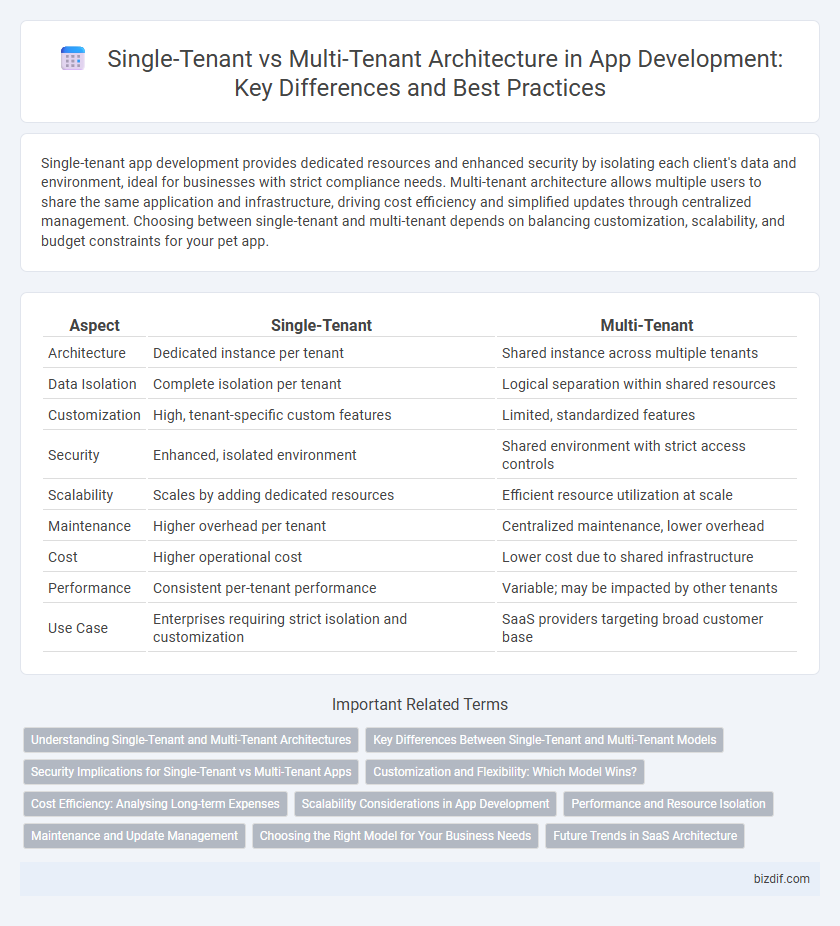Single-tenant app development provides dedicated resources and enhanced security by isolating each client's data and environment, ideal for businesses with strict compliance needs. Multi-tenant architecture allows multiple users to share the same application and infrastructure, driving cost efficiency and simplified updates through centralized management. Choosing between single-tenant and multi-tenant depends on balancing customization, scalability, and budget constraints for your pet app.
Table of Comparison
| Aspect | Single-Tenant | Multi-Tenant |
|---|---|---|
| Architecture | Dedicated instance per tenant | Shared instance across multiple tenants |
| Data Isolation | Complete isolation per tenant | Logical separation within shared resources |
| Customization | High, tenant-specific custom features | Limited, standardized features |
| Security | Enhanced, isolated environment | Shared environment with strict access controls |
| Scalability | Scales by adding dedicated resources | Efficient resource utilization at scale |
| Maintenance | Higher overhead per tenant | Centralized maintenance, lower overhead |
| Cost | Higher operational cost | Lower cost due to shared infrastructure |
| Performance | Consistent per-tenant performance | Variable; may be impacted by other tenants |
| Use Case | Enterprises requiring strict isolation and customization | SaaS providers targeting broad customer base |
Understanding Single-Tenant and Multi-Tenant Architectures
Single-tenant architecture hosts a single customer per instance, offering enhanced data isolation, customization, and dedicated resources, ideal for enterprises with strict compliance needs. Multi-tenant architecture serves multiple customers on a shared infrastructure, optimizing resource utilization and reducing costs through centralized maintenance and automatic updates. Understanding these architectures helps developers select the best approach for scalability, security, and performance in app development projects.
Key Differences Between Single-Tenant and Multi-Tenant Models
Single-tenant architecture dedicates a single instance of software and its infrastructure to each client, offering enhanced data isolation and customization opportunities. Multi-tenant models host multiple clients on a shared instance, optimizing resource utilization and reducing operational costs while maintaining secure data segregation through logical partitioning. Performance scalability, security protocols, and customization flexibility significantly differ between these models, influencing application deployment strategies and client-specific requirements in app development.
Security Implications for Single-Tenant vs Multi-Tenant Apps
Single-tenant applications offer enhanced security by isolating data and resources within a dedicated environment, reducing risks of data breaches caused by cross-tenant vulnerabilities. Multi-tenant architectures introduce complexities in access control, requiring robust tenant isolation mechanisms and stringent identity management to prevent unauthorized data access across tenants. Proper implementation of encryption, continuous monitoring, and compliance adherence significantly influences the security posture in both single-tenant and multi-tenant app deployments.
Customization and Flexibility: Which Model Wins?
Single-tenant architecture offers superior customization and flexibility, allowing businesses to tailor the app environment to their specific needs without affecting other users. Multi-tenant models prioritize cost-efficiency and scalability but limit individual customization due to shared resources and standardized updates. For organizations requiring extensive configuration and personalized workflows, single-tenant solutions provide a definitive advantage in app development.
Cost Efficiency: Analysing Long-term Expenses
Single-tenant app development incurs higher upfront infrastructure and maintenance costs due to dedicated resources, while multi-tenant architectures distribute these expenses across multiple clients, reducing per-user costs significantly. Over the long term, multi-tenant solutions benefit from streamlined updates and centralized management, further lowering operational expenses. This cost efficiency makes multi-tenant models particularly advantageous for scalable services targeting wide user bases.
Scalability Considerations in App Development
Single-tenant app architectures provide dedicated resources for each client, enabling predictable performance and easier customization but potentially higher infrastructure costs and slower scalability. Multi-tenant systems share resources among users, maximizing hardware utilization and enabling faster scaling to accommodate growing user bases but requiring robust security and isolation mechanisms to prevent data leaks. Scalability considerations must balance resource allocation, maintenance complexity, and cost-efficiency based on user volume and application requirements.
Performance and Resource Isolation
Single-tenant app development offers dedicated resources, ensuring optimal performance and strong resource isolation by preventing data and workload interference between clients. Multi-tenant architectures share infrastructure among multiple users, which can introduce performance variability due to resource contention but improve cost efficiency. Isolating resources in single-tenant environments minimizes security risks and latency, making it ideal for applications demanding high reliability and consistent speed.
Maintenance and Update Management
Single-tenant app development allows for tailored maintenance and update management, enabling custom schedules and minimal impact on other clients. Multi-tenant architectures require coordinated updates that affect all users simultaneously, demanding robust testing and deployment strategies to ensure system stability. Efficient maintenance in multi-tenant systems leverages automation and continuous integration to handle frequent, large-scale updates without service disruption.
Choosing the Right Model for Your Business Needs
Single-tenant app development offers dedicated resources and enhanced customization, ideal for businesses requiring strict data isolation and tailored solutions. Multi-tenant architectures provide cost efficiency and simplified maintenance by sharing infrastructure among users, suitable for scalable applications with standard feature sets. Evaluating your business's security requirements, budget constraints, and scalability goals ensures the optimal tenant model aligns with your operational priorities.
Future Trends in SaaS Architecture
Future trends in SaaS architecture indicate a growing adoption of multi-tenant models due to their cost efficiency and scalability for app development. However, single-tenant architectures remain relevant for industries demanding enhanced data isolation and compliance, such as finance and healthcare. Emerging hybrid solutions aim to combine the flexibility of multi-tenancy with the security benefits of single-tenancy, driven by advancements in containerization and cloud-native technologies.
Single-Tenant vs Multi-Tenant Infographic

 bizdif.com
bizdif.com